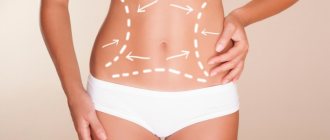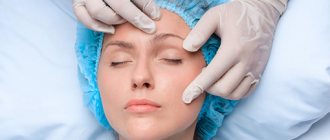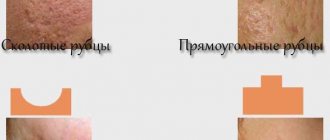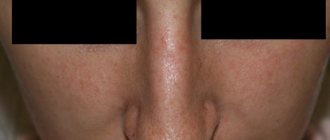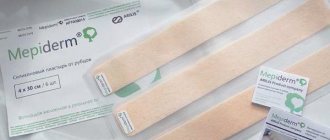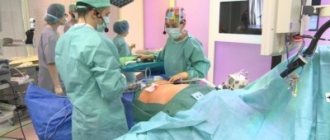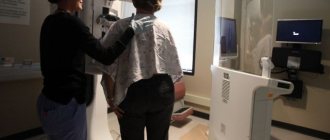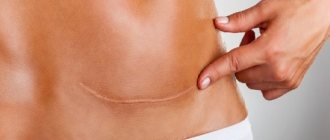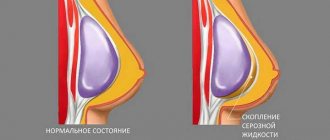The defect caused by surgical damage to the skin is filled with connective tissue (scar) over time. The process is irreversible, but there are ways to improve the appearance of an annoying flaw in appearance. This means that scar treatment after surgery is possible. There are various means and methods to make scars almost blend in color and texture with the surrounding areas of the skin.
Types of scars and scars on the face
There can be several reasons for the appearance of scars . There are several main types of scars:
- Normotrophic . The scar is formed during the normal healing process of connective tissue in the absence of even minor complications. A scar may appear as a result of minor surgery after the stitches are removed. The area of skin and the scar itself do not differ in color from healthy skin; the scar is flat and invisible.
- Atrophic . A scar appears on the face after the removal of moles or other tumors. Acne marks can transform into the atrophic type. The scar is formed by loose tissue in which the level of collagen is reduced. The mark is often round, forming a notch on the surface of the epidermis. You can find out how to overcome scars at home here.
- Hypertrophic . The formation of the mark is preceded by a genetic predisposition to increased tissue growth, long-term non-healing burns and insect bites. Suppuration of the wound can lead to improper scarring. The mark may be convex relative to the skin and have a pinkish tint.
- Keloid scar . The affected skin area resembles a tumor. The size and extent of the lesion depends on the location, type of injury, and genetic predisposition to scar formation. The scar has a red or bluish color, with a bumpy surface.
Marks on the skin of the face that appear after surgery can belong to all 4 types of scars.
Scars - symptoms and treatment
If the patient comes in at the time of injury, then for a scar of better quality, primary surgical treatment of the wound, excision of clearly non-viable tissue, and removal of foreign bodies to reduce contamination of the wound are important. The importance of a dressing appropriate to the type of wound cannot be overestimated [6]. Surgeons have been using both hydrogel and vacuum dressings for a long time and see their tremendous help.
Treatment of already formed scars should be based on the type of scar and its age. Treatment can be staged (and therefore long-term) and complex. In clinics where complex treatment of patients for aesthetic reasons is carried out, protocols for the rehabilitation and treatment of various types of scars are usually developed, so the patient after aesthetic surgery begins to work with a cosmetologist almost from the first day after the injury.
Surgical and conservative treatment is possible. Surgical involves excision of the scar, triangular or other type of plastic surgery. Sometimes it is enough to perform Limberg plastic surgery. The method is based on cutting out and mutual counter movement of two adjacent triangular flaps consisting of skin and subcutaneous fat. In this case, it is necessary to position the lines of the scar in greater accordance with the lines of skin tension in order to transform the scar from hypertrophic to long, but normotrophic, which does not cause concern.
Extensive scars can be successfully treated using the dermotension expander method, when an expander is placed under a nearby area of skin. The expander is a hollow silicone balloon, adapted for the gradual (over several weeks) introduction of saline into it. This leads to gradual dermotension (stretching) of the skin, which is subsequently used for skin grafting. In this way, in a few months you can get a large amount of skin identical in color and texture (for example, to cover the scalp).
Conservative methods may be controversial or supported by many years of research. Controversial methods include cryotherapy, radiation therapy, x-ray therapy for scars - they do not always give a good result. Sometimes their damaging effect is greater than can be predicted. Confirmed ones include injections of hormones, enzymes, plasma therapy, phonophoresis, etc. Research on cellular technologies, such as injections of stem cells or neofibroblasts, is of great value [13].
Also interesting are treatment methods using veropamil ointment, acemin, rubbing in vitamin E, and the use of cytokine preparations. It is advisable to develop these methods, as they can be effective and useful in identifying the processes occurring in the wound. But in practice, they can be difficult to apply due to the duration, labor-intensive or high cost of treatment.
Atrophic scars take a long time to treat, are difficult and may not give a clear aesthetic result. They use peelings, laser treatment, injections of collagen and hyaluronic acid, as well as darmabrasion - grinding off the surface of the epidermis. If dermabrasion is done very roughly, it can lead to the formation of new scars. Surgical methods include excision of an area of skin with stretch marks (after all, most often it is the abdomen with many stretch marks).
Normotrophic scars can be quite effectively treated with therapeutic methods to improve quality, for example, smearing with silicone gels and immoferase. These products will speed up the maturation of the scar and quickly turn it from red to white. In addition, a month after the injury, you can inject the scar with your own blood plasma or Spherogel, which will help make the scar as blurred as possible. If the scar is whiter than the surrounding skin, tattooing it is used with great success.
Hypertrophic scars respond well to treatment with injections of hormonal drugs, the use of hormonal ointments, and silicone gel applications, such as Kelo-Kot or Dermatix. The action of these drugs is based on the occlusive effect (moisture evaporation is blocked), scar hydration and reduction of collagen synthesis. Corticosteroid injections can help achieve rapid improvement in hypertrophic or keloid scars. Sometimes in practice, 1-2 injection procedures are needed to transform a hypertrophic scar into a normotrophic one. The keloid scar stops itching after the first procedure, which significantly alleviates the patient’s condition. The principle of action of corticosteroids is based on a powerful anti-inflammatory effect, inhibition of fibroblast division and increased activity of its own collagenase.
Injections of enzyme preparations such as hyaluronidase and longidase treat not only skin scars, but also deep cicatricial deformities such as Dupuytren's contracture. This is a scar degeneration of the palmar tendons, in which the fingers are bent towards the palm and their full extension is impossible.
Not only the injection will improve the condition of the hypertrophic scar, but also phonophoresis with these enzyme preparations, which increases the availability of treatment. Surgical treatment consists of triangular scar plastic surgery—reorientation of the scar line is performed so that its direction coincides with the skin tension lines.
ways to treat keloid scars , which means that there is no 100% effective method. Injection of hormones, such as Kenalog, significantly improves the quality of the scar and relieves itching. Pressotherapy in studies gives quite good results. This is constant pressure therapy, for example using an elastic pressure bandage. This can be done using compression garments or silicone plates. It was experimentally revealed that a pressure of 25 mm Hg. Art. for every centimeter of skin it compresses blood vessels, limits their growth and softens the scar, until it is completely smoothed out. Silicone plates dry the surface of the scar, extinguish pathological inflammation in the scar and also significantly alleviate the patient’s condition.
As with hypertrophic scars, good results can be expected from topical application of enzyme preparations (Fermenkol) or their injections into the scar tissue. It is not recommended to perform primary excision of a keloid scar. Otherwise, in response to inflammation, an even larger scar will grow at the site of the excised tissue. If a person has a state of homeostasis in which a keloid scar is formed in response to injury, it is logical to assume that by removing the existing keloid the doctor will cause a new injury greater than the previous one, which means with almost 100% probability the scar will also become keloid and involve some kind of amount of healthy skin. This type of scar requires careful attention; there should be no rush to treatment.
When and why you need to remove scars on the face
Removal of a facial scar after surgery is permitted for medical reasons and if the scar is a cosmetic defect. Medical indications are based on the impairment of certain functions, such as deformities of the mouth or eye. Scar removal for cosmetic reasons is permitted provided the patient develops complexes.
The time for procedures to eliminate defects on the skin is determined by a specialist based on the individual characteristics of the patient’s body.
When choosing a mark removal method, there are a number of factors to consider:
- location of the mark;
- the presence or absence of deformed blood vessels;
- type of injury;
- hereditary indicators;
- patient's age;
- physiological characteristics.
The procedure to remove marks after surgery should be carried out no earlier than 16-24 months after surgery.
The scar must be completely mature.
The most effective ways to get rid of facial scars after surgery
There are several ways to remove marks on leather. Scars are eliminated with the help of modern technologies, medications and traditional medicine. Popular methods:
Freezing
Traces caused by surgery are removed with liquid nitrogen. The procedure must be carried out in a specialized clinic. a cotton swab soaked in the solution to the deformed area of skin for 1-3 minutes. After the deep freezing procedure, swelling and blisters form on the skin, which burst after 5-7 days. Healing lasts 21 days, the scar gradually becomes lighter.
X-ray therapy
The method can be used as a preventive method. Suitable for removing fresh keloid scars . The timing of the event and the radiation dose depend on individual characteristics. Beech irradiation is recommended for use after cold freezing. The scars disappear quickly.
Dermabrasion
Scar removal is based on mechanical grinding of the marks. The specialist uses special brushes and cuts off the scar. Anesthesia is required.
There may be some minor bleeding after the procedure. Therefore, it is recommended to consult a doctor before using this procedure.
Laser
Mark removal is carried out using carbon dioxide and erbium lasers. When the laser is heated, the skin on which the scar is located evaporates . The rays have an antibacterial effect on the skin. There are no stitches. The event is carried out under anesthesia.
Collagen and adipose tissue
Scars after surgery or an accident on the face can be smoothed out with collagen or subcutaneous fat. Collagen or products containing hyaluron into the area where the mark is located The method is not radical; with this method, the scar resolves within one and a half to two years.
Additional therapeutic medications to remove the scar
- Diprospan;
- Kenalog;
- Ronidaza;
- Lidaza;
- Bleomycin;
- Fluorouracil.
The integrated use of medicines and modern equipment makes it possible to eliminate the scar that has healed (photos of the scar before and after below).
Choosing a scar removal method
Scar removal after surgery can be done in several ways. A dermatocosmetologist should select a specific one. He evaluates the appearance of the defect and the degree of blood supply to the tissues. After this, the following may be prescribed:
- external medications;
- injections into the scar area;
- physiotherapy;
- deep dermabrasion;
- chemical peeling;
- massage with vacuum and rollers;
- mini-surgical intervention in the form of cryotherapy, laser or electrocoagulation;
- Plastic surgery.
The removal method is selected depending on the location, nature and size of the scar
It is worth remembering that folk remedies will not cope with serious skin changes. As a result, you can lose time to such an extent that even a laser will not help in eliminating the trace. Therefore, it is necessary to trust the dermatologist who determines the treatment tactics.
Home remedies for removing facial scars after surgery
Scar removal procedures can be carried out using traditional medicine. These include:
- essential oils;
- cabbage leaves;
- medicinal herbs.
Eliminating scars using traditional methods takes a long time.
Essential Oil Blend
To prepare a mixture of essential oils, you need to take 5 ml of rosemary, mint and neroli oils. Apply the prepared mixture to the mark daily for 60 days.
Cabbage compress
Grind a few fresh cabbage leaves until mushy. Add 10 grams to the resulting mass. melted honey. Apply a thin layer of the product to gauze folded several times and apply to the scar for 90-120 minutes. Repeat the procedure daily until the scar is completely resolved.
Collection of medicinal plants
The aerial parts of calendula, yarrow, chamomile, St. John's wort, nettle, sushi and knotweed must be taken in equal parts and mixed several times. 15 gr. pour 300 ml of boiling water over the resulting mixture. Let the broth cool. Soak gauze in the resulting solution and apply to the deformed area of skin.
The best options for covering a scar
Scar removal may not be possible due to a number of medical contraindications. In such cases, you can use a number of popular methods, which include:
- Covering up a tattoo scar;
- Applying makeup;
- Peeling procedures;
- Cosmetic resurfacing.
The method must be selected based on the degree of skin damage, location and other individual characteristics of the patient.
Tattoo
Old scars can be disguised with a pattern applied to the skin . The size and shape depends on the client's preferences. The procedure is carried out by a professional using special equipment. The paint is “driven” under the skin, completely covering postoperative marks, scars and scars.
Grinding
The masking procedure is carried out using a laser.
Neodymium rays remove the keratinized layers of the epidermis and can significantly reduce the density and size of the scar. Resurfacing has a number of contraindications, the absolute ones of which are pregnancy and breastfeeding. When performing laser facial resurfacing, the specialist must take into account :
- skin condition;
- scar type;
- age restrictions.
The appearance of swelling and pain at the grinding site is inevitable. Unpleasant symptoms disappear on their own after 4-7 days.
Cosmetics
You can hide scars on your face using cosmetics . Experts recommend adhering to a number of rules:
- makeup should be applied to previously cleansed facial skin;
- masking is carried out using a pigment primer;
- camouflage concealer must be applied directly to the scar;
- foundation is applied to the concealer in a thin layer;
- Powder is applied to the scar as a setting touch.
To prevent the attention of others from being focused on the scar, it is necessary to make the eyebrows, lips and eyes more expressive.
Peeling at home
Peeling can be used to eliminate cosmetic defects in the form of a scar on the face . There are several main types of peeling:
- laser;
- microcrystalline;
- phenolic;
- retinoic.
Peeling mechanism of action
- under the influence of acids, scar tissue dissolves;
- metabolic processes at the cellular level are enhanced;
- independent production of hyaluron and collagen by the epidermis is launched;
- after peeling, the scar peels off and falls off along with the crusts;
- After the procedure, new skin at the scar site is formed in 10-12 days.
Self-removal of crusts is unacceptable. The scar will not only not disappear, but may also increase in size.
Postoperative scar care
In order to prevent the formation of rough scars, it is necessary to follow procedures aimed at proper care from the first days after surgery. Among the basic rules are:
- During the first week after the operation, daily dressing of the wound with treatment and application of a sterile napkin is required. In addition to a cotton gauze napkin, you can use a special plaster.
- If there is no suppuration or wetting, postoperative scars are treated with a solution of brilliant green.
- If the wound begins to turn red, an infiltration zone is identified, or it begins to get wet, the use of agents that have an anti-inflammatory effect is required. Among them, the most popular drug is Levomekol ointment.
- After a week, when the suture material is removed and there are no signs of inflammation, there is no need to apply a bandage. It is necessary to contact a specialist about how and when to remove the sutures after surgery.
- When preserving the suture material, it is forbidden to allow it to become wet, as well as to allow contamination of the skin of nearby tissues.
- It is prohibited to use an alcohol solution to treat a postoperative suture. This can cause the exposed surface to burn and increase keloid formation.
- In order to clean the surface of dried blood particles, as well as remnants of bandage or gauze. Removing them may cause bruising. That is why it is necessary to first apply a large amount of hydrogen peroxide, which helps soften the crusts. This will ensure their smooth removal from the surface of the wound.
Treatment of the suture after surgery should be carried out using sterile instruments and carefully cleaned hands. It is forbidden to reuse dressing material, as this may cause infection.
Important Tips
Experts recommend a responsible approach to facial scar removal procedures . Some tips:
- Before removal, you must consult a specialist and pass all tests.
- When choosing a method, you need to take into account the individual characteristics of the patient.
- Cosmetic procedures have contraindications.
- Folk remedies against scars have a prolonged but gentle effect.
- Concealing small scars on the face can be done using special makeup stickers.
- Electro- and phonophoresis can be used as additional methods for removing a scar on the face.
A dermatologist will help you choose the appropriate method. In advanced cases, you may need to consult a plastic surgeon and cosmetologist.
Possible complications
If you choose the wrong method for removing marks on the face, complications may arise . These include:
- Damage to healthy skin.
- Infection in scar tissue.
- Prolonged recovery period.
- Hyperpigmentation on the epidermis.
- The appearance of benign tumors.
A specialist who will take into account all possible risks and choose the appropriate method will help prevent complications. In severe cases, complex therapy may be necessary, including drug treatment and cosmetic procedures.
Plastic surgery as a way to remove scars
Plastic surgery is performed when more gentle methods do not bring results. Scar tissue is subject to intervention when keloids form in accidents or moderate burns. The surgical operation directly depends on the type, size and shape of the mark. The intervention must be carried out under general anesthesia. The rehabilitation period takes place under the supervision of a specialist.
Narrow and small scars can be removed through a simple operation. The mark is sutured and cosmetic stitches are applied. After healing, the scar leaves a barely visible light mark on the face.
If the skin is extensively covered with scars, expander plastic surgery will be required. Bags filled with silicone or special expander fabrics are sewn under the epidermis. The scar itself cannot be touched; the intervention is carried out on the skin near the scar. The sewn-in bags are filled with the solution gradually, which leads to smoothing of the scar tissue. Once the new tissue has completely formed, the silicone bags are removed. The edges of the skin are neatly connected to each other.
What is granuloma?
If surgeons used non-absorbable suture material, a postoperative scar granuloma (the body's reaction to foreign particles in the skin) may occur.
Starch or talc used for surgeons' gloves and microorganisms often get into the surgical wound (if asepsis rules are not followed). The formation of postoperative scar granulomas is prevented by the use of self-absorbable, hypoallergenic types of suture material.
Granuloma impairs the functions of tissues and organs; large accumulations of such formations compress blood vessels and nerves. Fibroblasts form around and scarring occurs. Treatment is usually carried out in a medical facility and involves excision of the connective tissue with granulomas. If the cause of inflammation is suture material, all remaining fragments are removed.
Gels and ointments that soften scar tissue
To soften scar tissue before mark removal procedures, experts recommend using special ointments and gels. Popular means include:
- Curiosin;
- Contratubeks;
- Mederma;
- Fermenkol.
Curiosin
Curiosin is classified as a healing agent with anti-inflammatory, antimicrobial and reparative properties . The active component in the gel is zinc hyaluronate. The drug is approved for use for medicinal purposes to eliminate minor fresh scars.
Contratubeks
Contratubeks refers to external agents that are used to soften scar marks . The drug contains 3 active ingredients:
- onion extract;
- allantoin;
- heparin.
The course of treatment lasts 3-4 months, the gel must be distributed in a thin layer over the deformed area of the epidermis and left until completely absorbed. Excess must be removed with a damp cloth. Repeat the treatment procedure 2-3 times a day.
Mederma
Mederma allows you to reduce the width of the scar . The drug has a light, non-greasy structure and is quickly absorbed. The active components are onion extract and allantoin. The medicine must be applied regularly, at least 2-3 times a day for 6-7 months. Mederma has virtually no contraindications and does not cause side effects.
Fermenkol
Fermenkol refers to cosmetics that have a resorption effect .
Under the influence of the gel, the area of the affected area of the epidermis is reduced, and the scar tissue is gradually smoothed out. Fermenkol is considered a modern anti-scar agent, including collagenase. The gel is applied in a thin layer to the deformed dermis. The product cannot be rubbed in. The procedure is carried out 3-4 times a day. The course of treatment is 30 days.
Cream "Malavtilin" - an achievement of Russian cosmeceuticals
Many preparations for external use accelerate the regeneration of cells and tissues, promote the resorption and healing of scars. When answering the question of how to remove a postoperative scar, experts often mention physiotherapeutic treatment in combination with the use of ointments. For example, with the information-active drug “Malavtilin”
Cream "Malavtilin" affects the skin, nerve endings, and biological active points.
Application effect:
- antiseptic;
- antibacterial;
- antivirus;
- anti-inflammatory;
- anesthetic;
- decongestant;
- deodorant.
Active ingredients in the cream: aloe vera, juniper, jojoba, macadamia oils, hyaluronic acid, malavit, plant extracts (calendula, eleutherococcus, horse chestnut, chamomile). They produce the cream in 50 ml tubes (price 300 rubles).
Answers to your 3 questions about removing facial scars at home
Is scar removal by freezing considered a safe procedure?
In most cases, no undesirable consequences occur after creodestruction. In patients with a genetic predisposition to the formation of scar tissue, relapses are possible.
Which ointments against scars are more effective - hormonal or non-hormonal?
Hormonal ointments are more effective, while non-hormonal ointments are safer. Application should be carried out with the permission of a specialist and taking into account individual characteristics.
Electrophoresis with lidase - what is it?
The procedure is carried out using special devices that generate current. If you have the necessary skills, you can remove marks by electrophoresis yourself. It is necessary to moisten a napkin in the lidase solution and apply it to the deformed area of the skin.
Removal of facial scars should be performed by a certified professional. Scars left after surgery, like old marks, are not easy to remove. The appropriate method is selected individually, based on the general condition of the patient, the size of the scar and its location.
When is the use of medications prohibited?
The use of external medicinal preparations for scars after surgery is in some cases prohibited.
Ointments should not be used if:
- redness;
- herpetic rashes;
- red vessels;
- eczema with weeping areas, blisters, crusts.
Also, treatment is not carried out in case of exacerbation of chronic pathology, in the presence of an allergic reaction, especially in the skin, or an infectious lesion of the body.
One of the most progressive methods is laser resurfacing.
